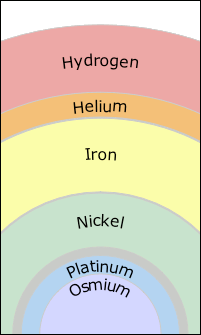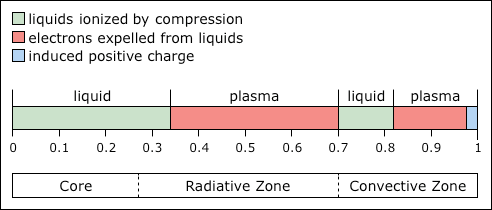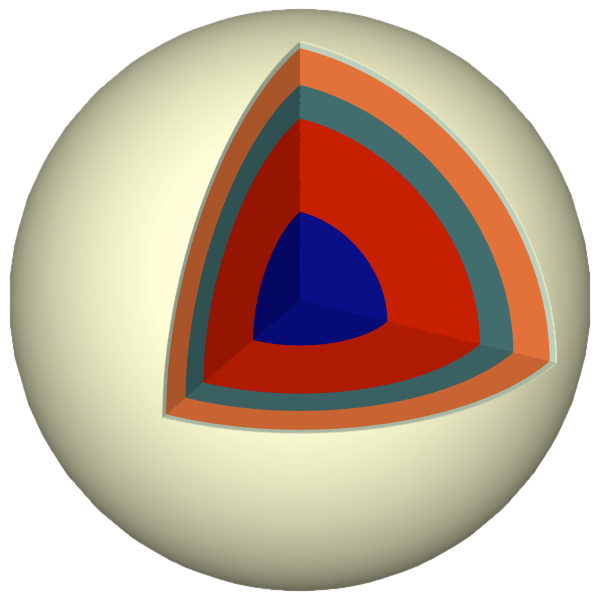Potentials
© Charles ChandlerThe previous section established that when electron degeneracy pressure (EDP) is taken into account, the overall mass of the Sun can only be achieved if there are heavier elements below the convective zone. (See Figure 1.) This is problematic for the energy budget in the standard model, which asserts that nuclear fusion in the core is responsible for the 3.86 × 1026 watts of EM radiation that continually stream out of the Sun.1 The model pressure (i.e., 2.35 × 1016 N/m2) and temperature (i.e., 15 MK) would certainly cause hydrogen fusion. But what if that isn't hydrogen in the core — what if it's osmium? The fusion of elements heavier than iron consumes more energy than it releases. So if the core and the radiative zones are made up of iron or something heavier, and if fusion is occurring in the core, it isn't an energy source — it's an energy sink, and the energy budget in the standard model is gone and then some. And getting it back will be quite impossible, as long as core fusion is the energy source. The force necessary for nuclear fusion goes up exponentially with the atomic number, hence the temperature would have to be exponentially higher. But that presents two more impossibilities.
- The gravitational force to maintain the density at that temperature isn't present.
- If there were temperatures up to the task in the core, thermal conduction would transport even more heat to the surface, and the net output of 3.86 × 1026 watts would be too low.
So the present model rules out core fusion. This, of course, does not mean that no fusion is occurring. Judging by the solar neutrino flux, fusion is responsible for 1/3 of the Sun's power.2 It just means that fusion isn't occurring in the core.Note that researchers committed to the "fusion furnace" model consider the low neutrino count to be proof that neutrinos spontaneously change flavor, such that in the time it takes them to reach the Earth, 2/3 of the electron neutrinos have changed into muon or tau neutrinos, which are not detectable.3 But modifying a theory to absorb an anomaly, and then calling the anomaly proof of the theory, is circular reasoning. Independent proof has not been established, and without it, that's just an unverified hypothesis. If we take the data at face value, we are still in search of something that can cause 2/3 of the solar output.This leaves us with two questions.
- What is the source of the other 2/3 of the energy?
- What are the conditions responsible for fusion, if not core pressure?
If we revisit the density gradient shown in Figure 2, we find another form of potential energy that needs to be investigated. Any hydrogen below the midpoint in the convective zone has been compressed into liquid, and most of the helium is similarly in liquid form. The iron and nickel in the radiative zone are above their liquid densities, but the platinum and osmium in the core are both below their liquid densities. If electron degeneracy begins at the liquid density, the core and the lower half of the convective zone are positively charged (green in Figure 3). Outside of these layers, the electrons expelled from the liquids will congregate, attracted to the positive charges, but not able to neutralize them because the density won't allow it (red in Figure 3). At the top of the convective zone, there is a layer of induced positive charge (blue in Figure 3). Hence there are 5 layers of alternating positive and negative charges.The significance is that the electrostatic potentials between these layers will be enormous. In the excellent conductivity of supercritical fluids, we'd think that the charges would spontaneously recombine. But the prime mover is gravity, which invokes EDP. Since the force of gravity is constant, the potentials should be stable, as long as nothing disrupts the layering. Yet the Sun is a very dynamic thing indeed, and we can expect constant disruptions. If the pressure relaxes, +ions created by EDP will be allowed to capture electrons. Conversely, if the pressure increases, electrons will be expelled. Thus anything that disrupts the pressure will drive electric currents, which will generate heat and light. So we'll investigate the possibility that the primary energy source is gravitational potential that has been converted to electrostatic potential in a CFDL configuration, and which is getting released by electric currents as the layers are disrupted.Figure 4. The proposed 5 layers of charge that are created by electron degeneracy pressure, given the proposed abundances that have been mass-separated, and the hydrostatic pressure from gravity. The electric force between oppositely charged layers further compresses them into the final equilibrium.
Blue = positive osmium, platinum, & nickel Red = negative nickel & iron Green = positive helium & hydrogen Orange = negative hydrogen Yellow = positive hydrogen If attributing the solar output to electrostatic discharges provides a more accurate description of the observable characteristics of the Sun, the "fusion furnace" model is displaced, and we are left with a new question: what are the internal temperatures, if they are not dictated by the fusion energy budget? We would have no reason to suspect that the core temperature would be any higher than the temperatures in the layers much nearer the surface that are hosting the discharges. They might even be lower, since the electric force in charge-separated matter removes degrees of freedom.4 So the temperature in the core might actually be absolute zero.The implication of this is that the heavy elements might not be hot enough to be highly ionized just because of the temperature. If this is true, they will become incompressible at their liquid densities. This is why the volumes of the elements in the solar interior, as shown in Figure 5, were based on liquid densities.And note that with this, we can now account for the acceleration of the surface waves in Figure 6. If the surface is positively charged, the electrostatic repulsion between +ions constitutes a resting force that is always there. If a wave is induced, these ions will not wait until they actually collide before transferring force. In fact, the electric force is so powerful that the ions never even collide. Rather, they exert force on each other as soon as the distance between them changes. So the waves are not limited to the speed of sound, but rather, the speed of light, minus the inertial forces in the ions themselves. This is why the waves accelerate instead of instantly reaching peak velocity.
References
1. Fröhlich, C.; Lean, J. (2004): Solar Radiative Output and its Variability: Evidence and Mechanisms. Astronomy & Astrophysics Review, 12: 273-320 ⇧
2. Koshiba, M. (2003): Nobel Lecture: Birth of neutrino astrophysics. Reviews of Modern Physics, 75 (3): 1011-1020 ⇧
3. McDonald, A. B.; Klein, J. R.; Wark, D. L. (2003): Solving the Solar Neutrino Problem. Scientific American, 288 (4): 40-49 ⇧
4. Caflisch, R. et al. (2008): Accelerated Monte Carlo Methods for Coulomb Collisions. Bulletin of the American Physical Society, 53 (14) ⇧













